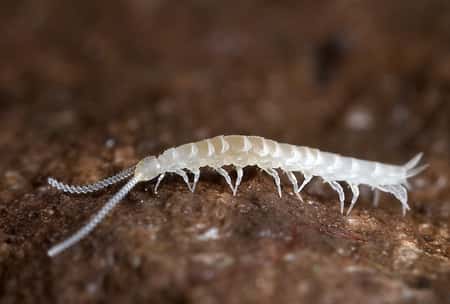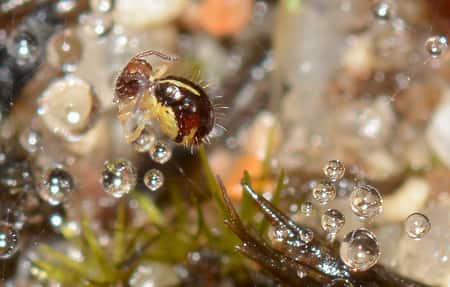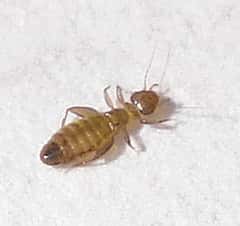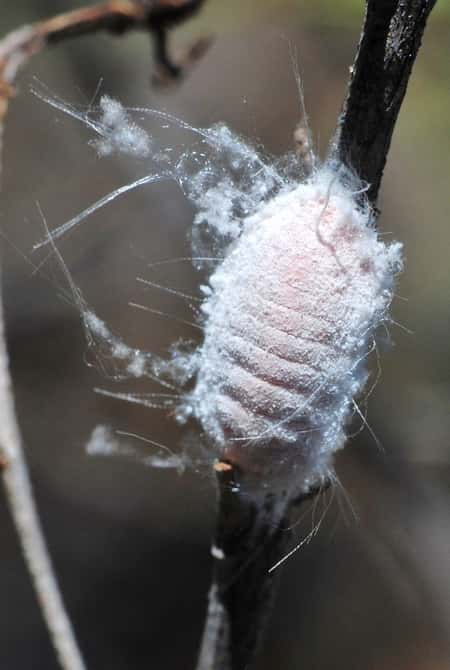Some kind of undesired bug is moving around in the orchid bark inside your pot. Due to that clear-plastic pot, you’re seeing more and more of them. Frankly, you wish now that you hadn’t invested in clear pots.
What are they? Insects? Pests? Overgrown Bacteria? Whatever it is, it’s not supposed to be there. Before you freak out and spray the entire orchid shelf with Raid, let’s identify the creatures to better eliminate them.
This article will focus on the specific bugs found in orchid bark. The pests and insects that inhabit the orchid bark potting mix are: symphyla, springtails, soil mites, psocids, and scale. The potting medium can be fir bark, pine bark, redwood bark, cypress bark, or any type of store-bought bark.
Other bugs that are more accustomed to being found in sphagnum moss—not bark, and you can read about those nasty creatures in this article I wrote about sphagnum moss bugs. There, I talk about spider mites, aphids, thrips, fungus gnats, and mealybugs, all of which prefer sphagnum moss to orchid bark.

This is the prettiest image on this page, so take a good look before we look at the nasty creatures!For now, let’s just focus on bugs in orchid bark:
symphyla,
springtails,
soil mites,
psocids,
and scale.
1) Symphyla: Tiny White bugs Who Love Orchid Bark
These little white moving specks don’t live around the leaves and flowers, but mainly love to stay inside the potting medium which is over 50% bark. They’re not slow-moving critters but move quite fast. I have to give due credit, so their real name is Scutigerella immaculata Newport, but I think Symphyla or Symphylan are easier.
Their eating habits are tender new roots but also fungus. You have a 50-50, bad-good situation here. They will rid your potting media of fungus, but they also chew on the new roots that are developing.
In the end, your orchid will suffer so they need to be dealt with.
It’s quite hard to see the effects of symphylan right away in your orchid because the growth doesn’t die off quickly, but becomes stunted. Your plant that once was vigorous and thriving will now be slowly wilting and suffering in silence.
If you live around Oregon, then this is probably what you have. Sympyla were a common crop problem in Oregon a couple years back, but due to better control, the numbers have come down.

They are actually arthropods, and if you look very closely, they are related to centipedes. With 6 to 12 legs, and only 1/8 inch long, (0.3 cm) these little white critters have an exoskeleton that they molt in time.
If the white specks don’t move, you might be looking at the exoskeleton that they left behind.
Since symphyla are not insects, they won’t respond to any insecticides. To eliminate them, you can use two methods: repotting or keeping the roots in bright light.
The light-method is because symphyla are photophobic. If you expose the roots to high quantities of light, (for example: transfer your orchid to semi-hydroponics in a clear vase with exposed roots to light) they will find a better home that is more suitable for dark habitats. The former bark was perfect because they love aerated soil and dark crevices to hide.
If you aren’t a fan of semi-hydroponics, and want to keep using orchid bark, that’s fine. Just repot, and throw away all the old potting medium. Use new media and soak it well before using it. Make sure that all the roots are squeaky-clean before repotting.
2) Springtails: White, Jumpy Critters in Orchid Bark
Springtails are what you should be hoping for. Springtails actually are beneficial for your potting medium as they feed on the old decaying matter inside the orchid media. Orchid bark is perfect for springtails since they need hydration, aeration, and plenty of water.
Springtails are sold to add in terrariums, and if you don’t have them in your terrarium, you should. These innocuous little creatures add life to a terrarium and look like a miniature, transparent version of roly-polies. They will be larger than the symphylan, but if your infestation is small, they might be juvenile. Just wait around and see if they grow.
A springtail is easy to identify because they’re nervous, insecure creatures. If you get to close, they’ll get jumpy, like little fleas eager to get away quickly. They jump fast and high (for their height) and are extremely active. If your bugs are slow, you don’t have springtails.

If your orchid bark has springtails, you’re in luck.
Keep doing what you’re doing in orchid care because it’s working.
3) Soil Mites: Not the Same as Spider Mites
Soil mites, called Oribatid mites, are another type of orchid bark inhabitant. They are extremely easy to get rid of and aren’t considered a royal pest, so you’re fine. The best news: they aren’t harmful—thank goodness.
Soil mites, being the carefree critters that they are, take their time in getting to places, as they freely stroll along the top of your potting medium.
They are somewhat related to ticks and spiders, but not directly. Soil mites are drawn to humid, wood forests, which explains how they were attracted to your bark potting media. You might throw away your potting media bark, since sometimes soil mites can find their way to the bags when you purchase them.
Soil mites are very common in mulch, so if you are using bark chip mulch in your potting media, this might be why soil mites are present. I wouldn’t recommend mulch when you repot, and in this article about using mulch compared to orchid bark, I explain why.
Soil mites are not only bark eaters, they are fungus eaters, too. Since they eat the decomposing material in wood forests, they are attracted to the wood chips or bark in your potting media.
Soil mites are not harmful to your orchid, but they signal that something is not quite right with the pH of your media. Since they are attracted to humid, decomposing, and decaying material that is saturated with fungus, this means your potting media needs to be changed as of yesterday. The roots have probably decomposed and are attracting bacteria, which in turn attracts fungus. The fungus signals to the soil mites that a feast is in progress.
If you have soil mites, you also might have fungus gnats, which are the second sign your orchid potting media is overdue for a change. I wrote an article about fungus gnats and suggest a couple of ways to eliminate them.
Just remember that spider mites are not the same as soil mites. Spider mites will feed on the honey dew of your orchid and it will deform and wilt. Spider mites make webs and are almost impossible to see, being the web that calls attention.
If the soil mites are bothering you, remove all your potting media and spray your orchid with phsayn 20. You can check the price of Phsyan 20 on Amazon here (Affiliate Link).  Physan 20 won’t kill the soil mites, but it does treat the bacteria and fungus that are on the roots. Without the bacteria, soil mites won’t hang around long.
Physan 20 won’t kill the soil mites, but it does treat the bacteria and fungus that are on the roots. Without the bacteria, soil mites won’t hang around long.
Another method of eliminating soil mites is soaking your orchid. The soil mites are not hard to get rid of, and it’s almost a sin in my book to drown the poor little dudes, but it’s effective and efficient. You don’t need to use any chemicals or special products to eliminate them.
4) Psocids: A High-Humidity Orchid Bark Bug
Psocids are another microscopic pest problem that are commonly found in orchid bark. They are about 1 to 6 mm in size (0.03 to 0.2 inches), and infest humid, rotting wood. In the past, soft-bodied psocids have been related to old, decomposing wood in abandoned farmhouses, as they infest the bark and feed on fungus and bacteria.
They can’t survive in low-humidity climates, which makes your orchid bark the perfect place for them to infest.
You probably won’t get psocids if you have an indoor orchid collection, but if you are prone to taking your orchids outside in spring and fall, then your chances of an infestation rise.
These little critters can be all colors, white, brown, black, and anything in between. The most common psocids are yellowish-white. They are also called Psocoptera, book lice, or bark lice.
If you aren’t in Kansas, like I am, and you don’t take your orchids outside, then your infestation could be coming from a new house that was just built. They will accumulate in the construction material that is usually humid, and from there stay in the walls of the wood or drywall.

 Psocoptera: Embidopsocus enderleini
Psocoptera: Embidopsocus enderleiniThe good news: psocids, pronounced so-sheeds, will go away on their own if you’ve just moved in.
As soon as winter comes around and you turn on the heater, they’ll be gone. This happens because they do not adapt well in dry climates, and the air conditioner and the heater both suck the humidity out of the air.
Another good thought: psocids do not harm your orchid. They only feed on the fungus and bacteria in your orchid bark, not the orchid roots. They will chew on the bark, too, so the time the decomposition occurs will be faster. But as for your orchid, you’re safe. You’ll just need to repot.
If you don’t want them around, then dry your potting medium out and keep the humidity low. They won’t survive long without the humidity but your orchid will. Keep the humidity at an extreme low and the psocids will die after a few days. Don’t water for another four to five days, and all the eggs and larvae will die off, too. Once your infestation of psocids is dead, resume watering and turn on the humidifier.
You will need to keep a humidifier running for most indoor orchids. If you haven’t bought one and are thinking about buying one, my suggestion is this one on Amazon. (Affiliate Link) It’s what I use in my home office and was a good price.
It’s what I use in my home office and was a good price.
If you want to see how I got to that conclusion, I wrote this article about narrowing down the choices in between cool-mist, ultrasonic, evaporative, and warm-vapor humidifiers in this article, and it will give you a good overview of what to look for to meet your needs. The orchids in my home office have specific needs and aren’t the same as your orchid’s needs will be.
5) Scale: The Hardest Bug to Get Rid Off
These are the most common types of pests in the orchid potting medium, but you’ll first see them on the leaves. They’ll look like small brown spots caused but water spots, but in time they’ll grow. You can rub them off with your fingernail or use rubbing alcohol, which differentiates them from the bacterial spots caused by stagnant water.
There are so many types of scales that it’s hard to generalize and place them into one category. They can be dark yellow, hinting on a brown color, or they can be white to pinkish-cream colored, all depending on their species.
Scales can reproduce fast. Their entire life cycle can be completed in a matter of three months, and these little bugs multiple worse than rabbits. This is important to know because treatment will have to be continual and reapplied every 3 weeks to kill the newer larvae and eggs, even when the mature adults have passed on. They also spread quickly, so if you have one orchid with scale, check all your other orchids for the same.
The best treatment for scale is to use either soap and water and manually scrub each leaf. Other methods include soaking your orchid in a watered-down bleach solution for a couple of hours, or applying neem oil, alcohol, and insecticidal soaps. None of these ways will be effective if you don’t actually get in there and scrub those scale-infested leaves.

For scale, you can check out these products. All the links will lead you to the price on Amazon:
and Carbaryl (water-based emulsifiable concentrate).
If you’re not sure what your orchid has, start with scale by scrubbing the leaves. Then repot and spray the entire orchid with Physan 20. Repot with fresh media and isolate your orchid form the rest. This will buy you some time until you have researched the best treatment for your orchid.
Don’t Stop Learning!
If you want to be included in more information and get a 14-page fertilization guide, please sign up for my newsletter. I don’t spam, but send emails out bi-monthly with some curious topics of interest. If you want more information, click here to go to a specific page on this website where I explain it more in detail.

Also, if you are looking for an orchid journal to keep your notes specifically about orchid care, check out my 2 solutions for that on this page. If note-keeping isn’t your thing, then there is a free excel spreadsheet that you can download. Click here for more information on how to do that.
If you subscribe to my newsletter, I will send you a 14-page guide on the main tips of orchid fertilizer. It is downloadable and you can print it out on your computer. I designed the guide to double up as a coloring book, just to make it fun.
While your orchid is enjoying its new potting medium, check out this page where I describe the best pesticides and insecticides for each type of orchid bugs. It will give you a good idea of what to look for on the market and how to treat each specific pest.
Happy Cultivating!


Dear Amanda
What a wonderful article.
I have about 7 orchid plants. For years they Re bloomed so nicely .
When they “rested” I decided to repot them. I did everything by the “book”.
Got rid of the old material got new pots with side holes for air and bought miracle grow cores blend soil for orchids. The plants immediately started to give new roots and new leaves .
BUT , tiny tiny flies are around the plants. They are not white , more like smaller than fruit flies. Apple cider vinegar does not attract them.
D you have any suggestion of where to go from here?
I have healthy indoor plants in the same room and I am concerned that they too will get infected …
I need help.
With thanks
Karny
Hi, Amanda, I’m learning so much from your articles!
My orchids had fungus gnats last winter. I tried the yellow sticky traps and the 1:4 peroxide. I saw fewer, but they didn’t disappear until the weather got nice enough to open window. I haven’t gotten any new orchids until late summer and everything was fine until about 3 weeks ago, I have fungus gnats again! When do they come from?